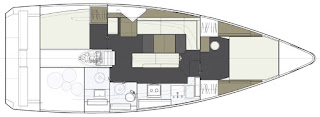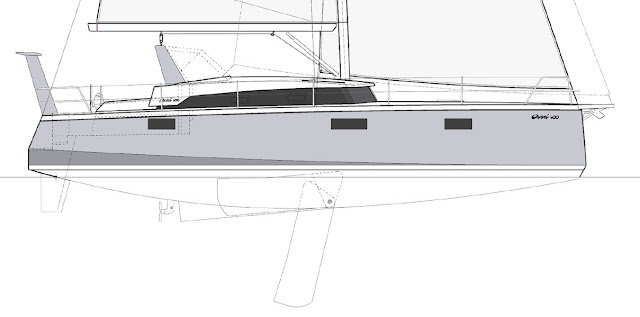When I saw on the nautical press the technical characteristics of the new OVNI 40, I could not believe them. They said that the boat has 2600kg ballast and displaced 11200kg. That gives a B/D of 23% and that, considering that the ballast is inside the boat, would not allow the boat to be certified as class A due to a poor final stability and AVS.
I checked on Alubat site and they apparently confirmed those dimensions. Only when I made the download of the boat brochure did things become different: contrary to what used to be, the centerboard is heavy and acts as ballast. It weights 1300kg, going down till 2.88m (draft).
Even if the centerboard does not seems to have more weight down than up, that changes things and the ballast is actually 3900kg, with some of it way down. That gives a B/D of 35% that, without being much, considering that most of it is inside the boat, will allow the boat to be certified class A, but I bet, very close to the minimum required in what regards stability.
The OVNI 395, the boat that this one substitutes, is surprisingly lighter (10 000kg) and with 3300kg of ballast plus the weight of the light centerboard that, if I remember right was something like 300kg, has a B/D of 36%. Considering that on the new boat the ballast CG is slightly lower due to a considerably part being down on the centerboard, the final stability and AVS of both boats should be very similar.
The OVNI 400 in what regards that mixed ballast system has resemblances with the Southerly, particularly the 42, that displaced 11250kg, with 3670kg of ballast having 2100kg on the bottom of the hull and 1570kg on a swing keel that had a max draft of 2.72m. The bigger ballast on the keel allowed the Southerly 42 RST to have a smaller B/D (33%) than the OVNI.
What this type of boats loses in static stability gains in dynamic stability, regarding a more conventional type of yacht with a big draft and a bulbed or torpedo keel with a similar B/D (or even smaller). This type of boat is able to dissipate better the energy of a breaking wave by sliding over the water instead of transforming it on a rolling movement.
 The smaller the area of keel (or centerboard), the better the ability to not trip over the keel and to slide with the push of a wave and these boats can put the centerboard up in really bad weather while running with the sea, escaping from a storm. It is worth noting that contrary to the 395 the 400 loses static stability with the board up.
The smaller the area of keel (or centerboard), the better the ability to not trip over the keel and to slide with the push of a wave and these boats can put the centerboard up in really bad weather while running with the sea, escaping from a storm. It is worth noting that contrary to the 395 the 400 loses static stability with the board up.  |
| Above, OVNI 395, below, Allures 399 |
The OVNI 400 is a medium displacement boat with a 203 D/L and with a moderate sail plan, one that certainly is accordingly to the boat stability and that on the standard version has a 17.3 SA/D ans with the “performance rig” (with a square top on the main) has 18.9 SA/D.
It would be interesting to make a comparison with the main competition, the Allures 399 that has also an aluminum hull but, contrary to the OVNI, for lowering the boat CG has a GRP sandwich deck. The Allures displaces 10 900kg, has a light centerboard that weights 200 kg, that adds to the 4000kg of ballast on the bottom of the hull. This gives a 39% B/D that compares favorably with the one of the OVNIs especially if we consider the lighter deck.
 The Allures has a better AVS and a better final stability. Its hull in what regards shape is a bit between the one of the OVNI 395 and the one of the OVNI 400. It has a similar SA/D (215.8) and a SA/D (16.9) not far from the one of the standard OVNI 400 (17.3).
The Allures has a better AVS and a better final stability. Its hull in what regards shape is a bit between the one of the OVNI 395 and the one of the OVNI 400. It has a similar SA/D (215.8) and a SA/D (16.9) not far from the one of the standard OVNI 400 (17.3).
The sailboat performances should be quite similar, except on strong winds downwind were the 400 should be faster. Both have equally powered engines (50hp), good enough to give them almost a motor-sailor ability and have a large tankage: the Allures 330L water, 400 L diesel and the OVNI, water 550L, diesel 500L.
What really is much better on the OVNI 400, compared with the OVNI 395, is the interior space, not only because the boat has more interior space due to more beam and the beam all pulled aft, but because the interior is much nicer, with an all around panoramic view that besides that allows to sail the boat from the interior.
 The 3D drawings show a very nice, functional and comfortable interior. The boat has many possible layouts even if on a boat that is aimed at long range cruising the ones with the 3 cabins don’t make sense, if that is the way the boat is going to be used. Both the two layouts with 2 cabins are well thought being the only difference two heads (and a smaller forward cabin) or one head with a separate shower cabin.
The 3D drawings show a very nice, functional and comfortable interior. The boat has many possible layouts even if on a boat that is aimed at long range cruising the ones with the 3 cabins don’t make sense, if that is the way the boat is going to be used. Both the two layouts with 2 cabins are well thought being the only difference two heads (and a smaller forward cabin) or one head with a separate shower cabin.
Another interesting feature is a hard sprayhood. But if they use one they need to provide openings for ventilation that are not shown on the drawings. The running rigging has some unusual features, namely a large traveler for the main over an arch and shows also a nice but small traveler over the cabin for the frontal sail on a position that should provide an excellent sail trimming while close hauled.
Not big enough for a big genoa, a type of sail that seems to be interesting on this boat. Probably the position of the stays would prevent its use anyway with the traveler on that position. A new traveler over the deck would be needed for a 140% genoa.
Four winches are shown on an intriguing position, under the sprayhood. Maybe they are thinking into putting them on a position that will allow their use on a completely protected area but I don’t think that is justifiable. I hope that they revise that because it makes not much sense having all the winches away from the wheels and having to cross the cockpit area to work on them.
I like the boat design with its slightly inverted voluminous bow, raised cabin and the elegant transom arch to support solar panels, wind generator and eventually to serve as davits for a dinghy. The design is from Mortain & Mavrikios a firm that was responsible for some interesting designs but that on the last years has not done much work.
All in all a very interesting proposition that could be a lot more interesting if instead of having 1300 kg on the centerboard it had a swing keel with all the ballast on the keel. That could lead not only to a boat almost 1000kg lighter with a better safety stability and a better AVS but also to a more powerful and fast boat, one that could be a benchmark on this category.







































